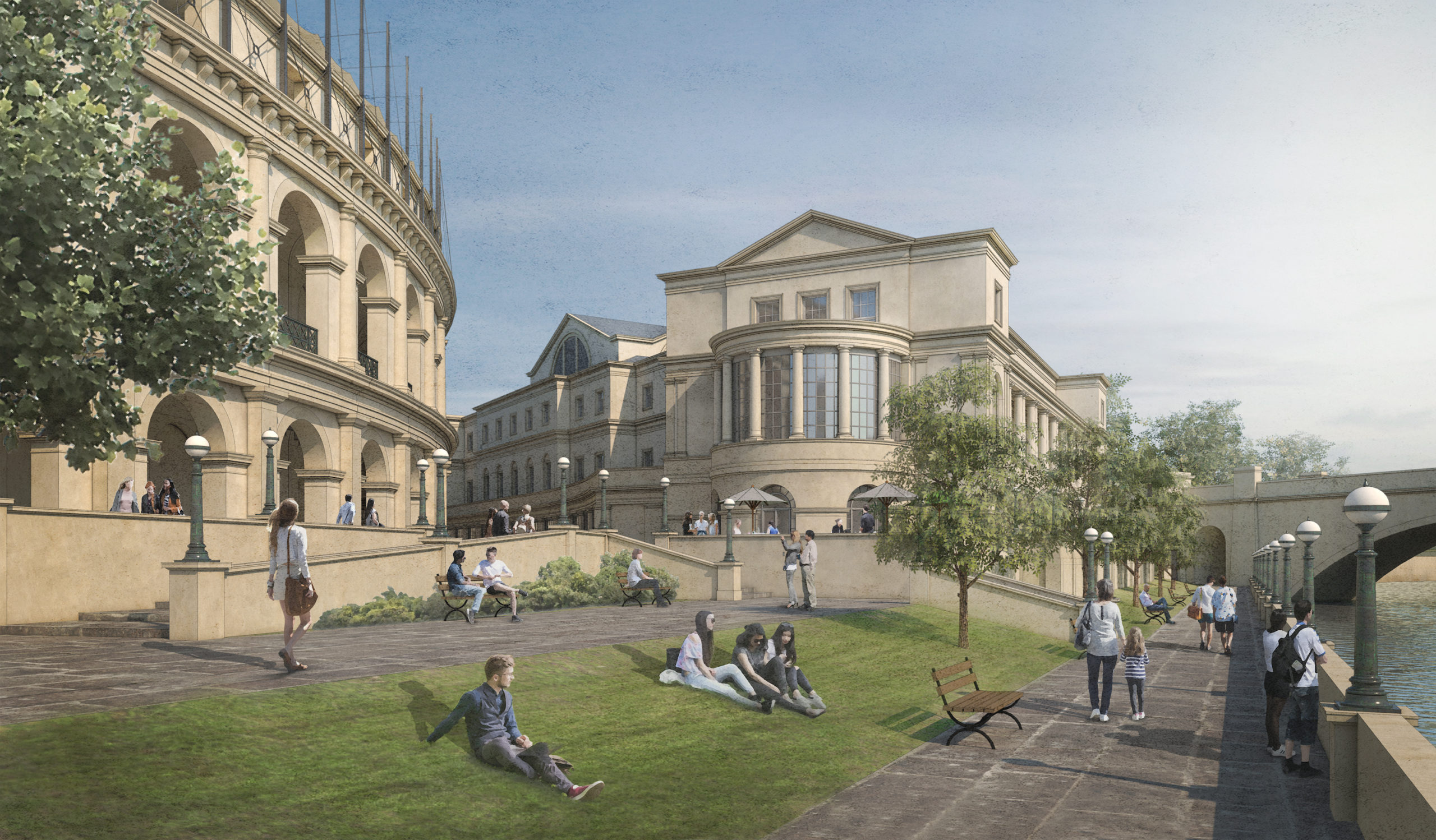Britain’s architectural landscape offers much to celebrate, but it is in a fragile state and, even if the prognosis may be improving, its future health cannot be taken for granted. We face a choice as to which way we move forward with the new development our growing population needs. On the one hand there is an encouraging renaissance of traditional urban planning principles that promote neighbourhood quarters, streets, squares, mixed use, pedestrian movement and so on. On the other there is a mindset still wedded to the kind of thinking that conceived the cocktail of demolition, traffic engineering, standardised construction and budget slab blocks that ravaged our towns and cities in the decades following WWII.
After WWI there was every reason to seek to answer the incredible challenges then facing society with radical new strategies, while the appeal of the avant-garde and new imagery invoking speed, progress and modernity was equally understandable. But ideas and experiments degraded into dogma, especially in the sphere of architectural education and related professions. Post WWII certain notions became axiomatic, practically articles of faith, for example that the engine of progress runs on change, demanding a clean break with the past and starting again (as if from tabula rasa). Some modernists married such beliefs to the avant-garde strategies of subversion and shock, while simultaneously portraying tradition and classicism as mere perpetuation, meaning (by a clever twist of logic) that both should be perpetuated no longer.
Modernists also set the agenda for the Venice Charter and other guidance that pushed the credo that new additions to historic environments have to stand apart as ‘of their own time’, in the name of the gods of authenticity, honesty and the ‘Zeitgeist’. But these are false gods; none of them stand up to proper scrutiny. We who write here affirm this from the perspective of insiders; one of us is an architect and architectural historian who has taught history, theory, studio and conservation at the University of Bath for over twenty years, the other an ex-student of the same top-ranked department. We’re amply familiar both with the mindset and the thinness of the argumentation on which it is based. Yet those who would deploy patterns and forms associated with history are still likely to suffer the pejorative charges of ‘pastiche’, ‘mere copying’ and worse.
The population at large, however, still retains a grip on sanity. Most people value streets, squares and so on, and see it as natural to add to old building stock in a more or less a similar manner – for this is what had always happened before dogma took over. Hence the disquieting disjunction between the public on one side and their political representatives and professional actors on the other. The public tend to recognise buildings that foster a sense of place where they feel at home, while too many ‘experts’ still tilt in the opposite direction. This explains why there is much work to do for Create Streets, the Office for Place and allied bodies.
There is work to be done in Bath too, that jewel of Britain’s architectural heritage. The beauty of its predominantly Georgian streets, squares and crescents built of the local stone is universally recognised: by its residents and the price of their houses, by the number of tourists who flock there, and by its World Heritage Site status. It is not just a case of dealing with the wounds inflicted during the infamous ‘Sack of Bath’ and ham-fisted surgical insertions like the carbuncular Hilton. The real problem – because it pervades decision making – is that of attitude. Rather than sticking with the Post WWII mindset and glibly writing off strategies of continuity as ‘pastiche’, what is really needed is to move forward in genuine sympathy with the past.
The topical dilemma before the local council and their advisors is the resurgence of the longstanding question of whether to build a permanent rugby stadium on the ‘Rec’ (Recreation Ground), now that Bath Rugby – one of England’s finest clubs – has published their latest proposal to replace the jaded ‘temporary’ stadium they currently use.
That the existing stadium and adjacent areas have serious shortcomings is undeniable: connections to the rest of the city are poor; the impenetrable junction between the stadium and the 1970s leisure centre thwarts access from the river to the open green of the recreation ground; both complexes are unattractive and down-at-heel, offering nothing like the level of public amenity that the location merits. Nor do they suit the character of a historic city famed for its beauty.
Unsatisfactory as this situation is, Bath Rugby’s proposals threaten to make these problems worse. They would become permanent rather than temporary. Moreover, developing a steel and glass stadium on its own, and not together with the leisure centre, would torpedo any possibility of a happier long-term future for the whole area. Furthermore, some images published by the club suggest that the impact would not be so negative as in reality. This impelled us to visualise the real implications.
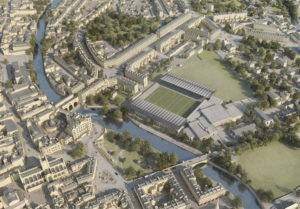
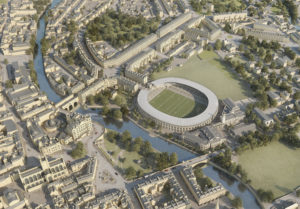
Already dismayed by previous proposals, we took on the challenge of creating a Counter Project on our own initiative – a vision of how things could be with sufficient will, investment and collaboration. With this we invite citizens and stakeholders to grasp two nettles: firstly, just how much is at stake, and secondly that there exist ways of making not only this site but cities in general more human and more successful. The ‘rival’ illustrations should speak for themselves.
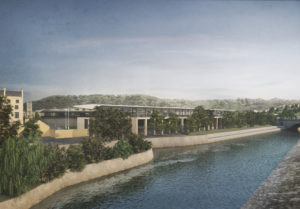
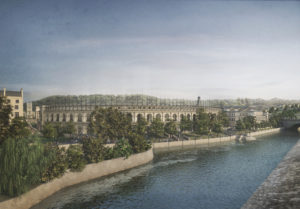
Our Counter Project aims to secure lasting value for Bath as a whole. The main key is planning the stadium in conjunction with the leisure centre. Another is using an oval and not a rectangle for the stadium. An oval has less bulk than a rectangle serving roughly the same capacity as Bath Rugby’s scheme, and it has no hard corners. A curving stadium can merge organically with its context, as do Bath’s Georgian crescents, softening the impact on critical views to and from the enclosing hills.
As for the leisure centre, instead of the current forbidding largely blank walls of concrete, we envision a contextual response that fosters pedestrian connections and usage, while making the most of the riverside. In terms of character and materials, kindred qualities to those of the buildings in the centre of Bath would continue over on the Rec side of the Avon. People would be drawn across the river, not just on match days but seven days a week, in the daytime and the evenings too. Bars, cafes, restaurants, shops and other amenities would hum with life, generating commercial returns while enhancing the environment.
The chief value of this vision lies in its urban aspects: connections, scale, grain, views, frontage, mix of uses, contextuality and materials. Style is a secondary issue, but, in the spirit of continuity and with respect for Bath’s heritage, we have opted for a classical architectural language. A declaratively ‘of our own time’ idiom can work for small-scale interventions (for example Thermae Bath Spa and the Holburne museum extension). At an urban scale, however, this ‘compare and contrast’ approach produces rifts that separate and divide.
The recent Southgate shopping redevelopment near the train station illustrates how even rather clunky traditional urbanism can help integrate a large scheme. It’s true that its town-house frontage belies the lumpy mass behind, while the poor detailing drags down the quality of the experience – but it’s possible to do better!
Working with tradition while using natural building materials (including stone that can be locally sourced), brings significant benefits too in terms of sustainability. Traditional buildings are inherently likely to be sustainable; they tend to last long and age well. Leaving aside greenwashing and eco-bling, true sustainability stems from creating beautiful and adaptable environments that will outlive present needs and contingencies because people identify with them and value them.
Only addressing the recreational ground holistically can serve Bath and its residents well for the decades if not the centuries to come. Short-termism is not just short-sighted – it is unsustainable. Bath will live long into the future, whatever we do, but it should be a good life, built beautifully now as it was when it originally flourished.
It’s a fork in the road for Bath and the council. Will they go with short-term expediency and Bath Rugby’s scheme, or will they look to the long-term health of the whole city? May the people of Bath and all who love the city join together and urge the powers that be to grasp the nettle even if it at first it stings!
Mark Wilson Jones and Jakub Ryng of Apollodorus Architecture. Mark has taught history, design and conservation at the University of Bath for over 20 years, and is a former trustee of the Bath Preservation Trust.


